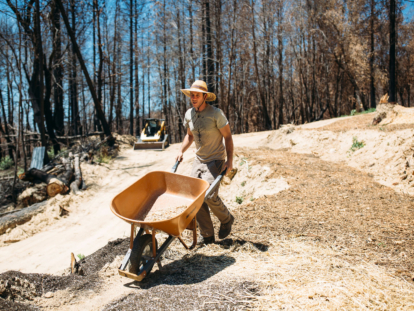Restoring Paradise
A road trip through California’s worst drought in 1,200 years, and the folks working to restore broken ecosystems and rewild lost landscapes.
All photos by Joel Caldwell
Editor’s Note: During the summers of 2021 and 2022, as parts of the western US entered the worst drought in 1,200 years, Joel Caldwell took a series of road trips through California’s Central Valley and points north to document folks who are working to restore broken ecosystems and rewild lost landscapes. Part of a global movement led by grassroots activist workers, these Ecosystem Restoration Camps (ERCs) exist, as ERC founder John D. Liu says, “as an example of a new way to live, a way to teach, learn and participate in saving human civilization.”
These seven camps, each in their own way, empower ordinary folks to change broken systems. From the off-grid community planting trees and building soil along a wasteland roadside, to a man growing a food oasis after spending half his life in prison, these people aren’t waiting around for others to take climate action.
I’m humming up the I-5 past Bakersfield in a white Chevrolet Spark. To the east, an immense feedlot stretches out of sight, stuffed full of unhappy cows, prisoners emitting a fetid odor that matches—or maybe creates—the brown cloud that my tiny car barrels through. It’s brutally hot. The first of many heat waves has descended upon California in the dry months of 2021, forecasted to stick around for the entirety of my first tour of the state’s Ecosystem Restoration Camps (ERCs), intentional communities and permaculture sites.
For the past four years I have immersed myself in the world of ecosystem restoration and rewilding. Professionally, I have researched and discussed, photographed and filmed, penned and promulgated hundreds of restoration projects around the globe. Personally, I have mulched, mucked, planted, burned, harvested, observed and connected. In the process of developing and feeding this new obsession, my attention has become increasingly focused on stories of hope, healing and environmental action. In short, I’ve undergone a bit of a personal transformation.
I continue north toward EcoCamp Coyote, the first ERC on my itinerary. As the dystopian landscape of factory farms and parched soil whizzes by outside the window, I turn up the volume on John D. Liu’s podcast, his voice tinny through the Spark’s speakers: “We should be able to drink from the rivers,” he says. “And we can in 100 years if we try really hard. This should be the intent of human civilization.”
ECOCAMP COYOTE | Santa Clara County, California
From wasteland to fertile ground.
From the outside, EcoCamp Coyote seems like a dubious place to set up an “ecosystem restoration camp.” After punching in a code, a chain link fence opens into a labyrinthine industrial wasteland. It’s dry and dusty, full of heavy equipment and stacked materials. Driving on, I see flashes of deep green on the grounds ahead and, to my surprise, catch the earthy, comforting scent of damp soil wafting through the window as I park the car.
I’m watching a downy woodpecker bore a hole in a lone black walnut tree, when Leo Lauchere, founder of the EcoCamp Coyote ERC, greets me. Leo is tall and rangy, sporting a septum piercing, a well-worn Lake Tahoe hat and a wide, welcoming smile. He seems totemic of the camp: a kind of mythic, vegan Mad Max character capable of catalyzing discarded trash into the materials that run a sustainable human community. “This was all gravel,” he tells me, waving his hand toward a particularly lush corner of the compound. “We spread a couple hundred yards of wood chips. I bought an old dump truck that I could barely keep running and dumped load after load of mushroom compost from a local farm. And now we have this soil,” he says with a hint of awe. “Sometimes we don’t even water the garden because it’s so thick.”
Leo guides me through the native plants and orchard trees. He shows me how they harvest rainwater and integrate it with a series of grey water systems that turn wastewater into irrigation. He established his camp on the extremely degraded soil of a former sod farm southeast of San Jose, California. A small community lives here, off-grid, and utilizes the urban waste stream to build structures, rebuild soil and restore the land.
Listen to Leo talk tinkering
Transcript
Leo: Tinkering is one of my favorite things to do. The maintenance of things, and the fixing of things, instead of building new things–or, buying new things, just goes into that larger ethos of taking care of things that are already here. Having that shop and developing at least a base level of different skills around electricity, around plumbing, welding, woodworking, is crucial for living this kind of lifestyle. We can fix things and take care of things, not just for ourselves, but for the next people who will use them.
The next morning, I awaken in a shipping container that primarily functions as a kiln. We eat a dense breakfast of leafy greens, rejects from a local grocery store, and spend the morning performing fire mitigation along the highway. “Once we started to outgrow the camp, we expanded to the roadside,” Leo tells me as we load up his 1964 Chevy K10, one of the few “gassers” he still operates in his 95 percent petroleum-free lifestyle. “It was being actively poisoned to control ‘weeds,’ so we took it over from the city.”
Chainsaws sing as we limb up oaks and clear brush from around their trunks. We haul loads of trash, old porcelain toilets and disfigured baby dolls, discarded relics that detail an unwelcome story of a throwaway culture’s disregard for the commons. The goal here is fire mitigation, but also the planting of trees, and Leo and his crew have collected acorns for months and planted them in their greenhouse. “Everyone interfaces with roadsides, but no one takes care of them. They’re just the most downtrodden, unsexy wastelands: roadsides,” Leo tells me. “I want the roads around here to be canopies of live oaks.”
That evening, Leo fires up a solar-powered light show, cranks the stereo and I participate in my first-ever session of “dance therapy.” A motley group of misfits, we wiggle and shake, laugh and smile, as the music loosens our tired bodies and minds.
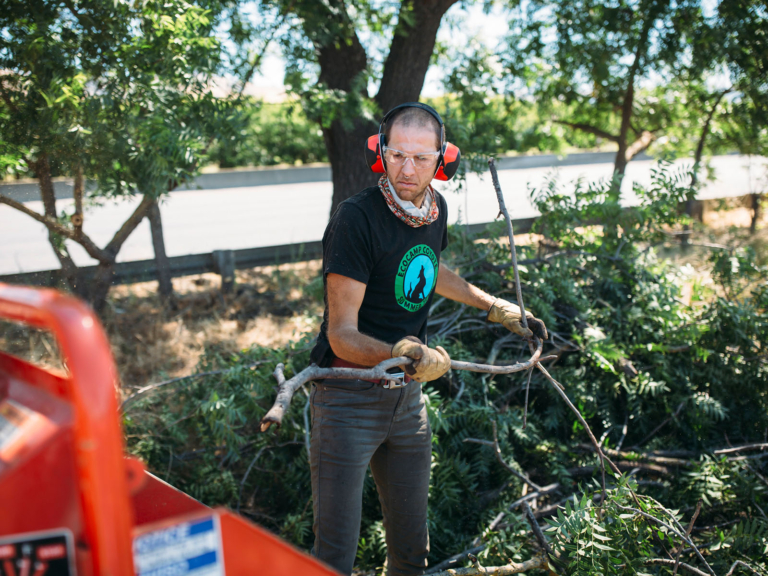
“Oaks feed so many species,” Leo Lauchere says. “And they’re fire-adapted. Getting them in the ground seems like a good thing to do.”
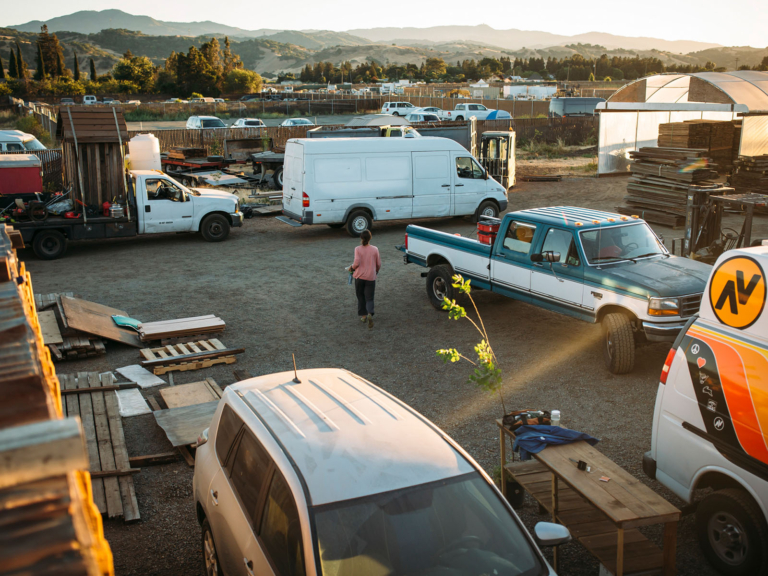
In addition to running Ecocamp Coyote, Leo, along with his business partner Ero Gorski, also operates Good News Wood Salvation in Coyote, California. The organization salvages redwood fencing destined for the landfill and repurposes it into a product suitable for accent walls in homes.
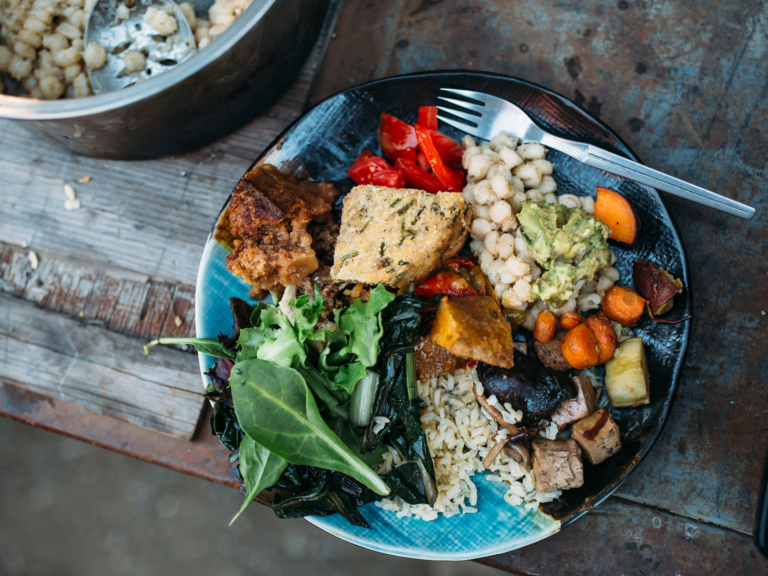
Straight out of EcoCamp Coyote’s vegan kitchen. Ingredients are gathered from local grocery-store rejects and the Coyote garden, and cooked using biogas, solar and wood power.
CANTICLE FARM | Alameda County, California
A former inmate regenerated.
“I spent half my life locked up,” says Troy Williams. “In solitary confinement, you feel a deep tension in your body. I was in a cell where I could reach and touch both sides. The window had been painted over from the outside, but there was a chip through which I could watch the birds line up, almost as if they were doing morning prayer. That became a ritual for me to connect with nature, to feel the harmony and flow. To wake up and look out that slit and see the birds lining up.”
I’m sitting with Troy amidst the abundance of Canticle Farm, a regenerative oasis in Oakland that seeks to function as a platform for “the great turning”—the planetary shift from an industrial-growth society to one that sustains life through a focus on social and environmental justice. Troy has lived at Canticle for the past seven years and, throughout our conversation—which is routinely interrupted by curious, bumbling pollinators—he paints a picture antithetical to where we sit: two and a half decades of imprisonment, surrounded by concrete and steel, and characterized by a complete removal from nature.
Troy cofounded The Green Life Project at San Quentin State Prison, connecting inmates to nature to facilitate healing. For the last eight years of his incarceration, he earned 37 cents an hour running San Quentin Television. He created programming and learned audio and video skills, but with a stick of deodorant costing $3, he was unable to save money and prepare for life on the outside. Paroled in 2014, Troy was given $200 and sent to a transitional house in the Bay Area. There was a dope spot next door, prostitutes hanging out on the corner. For Troy, it felt like a trap, a setup. “That sends a deep psychological trauma message,” he explains. “That you are not cared for.”
After a year in the transitional house, Troy heard about Canticle Farm. “I didn’t fully realize what I had been missing until I walked back here in the garden—this oasis of fruit trees, dirt and grass.” He describes a feeling of oneness, something that he cannot put into words. “On the inside, you try to replace [nature] with imagination, with memories. It keeps you sane enough, I guess, but it’s not the connective tissue, the knowing. Your body and mind feel restricted.”
At Canticle, I watch a team of volunteers and residents work among a riot of wildflowers to restore a creek long confined to an underground culvert. To me, this restoration—and Troy’s—illustrates the resiliency of humanity’s bond to that which sustains us, capable of transcending concrete, steel and other less visible, but no less pernicious, man-made obstacles.
Listen to Troy talk about transcending hard time
Transcript
Troy: I grew up with an ‘07 Bronco-bustin’, cowboy-boot-wearing brick mason father who was probably the hardest working man I’ve ever known in my life. I was about 25 years in prison. I went in when I was 27. I was sentenced to life with the possibility of parole. You couldn’t even see outside the cell. There just happened to be a chip in the paint on the window. And I used to look outside this slit and I would see all of the birds line up in the morning. And that almost kind of became a ritual for me to connect with nature in some kind of way. To feel the harmony of nature and the flow of nature, just to wake up and look out that little slit and watch all the birds, like, lined up in the morning. In 2014 was when I was actually paroled. I actually got to Canticle Farm and I walked back here in the garden, and this is sort of like a little oasis. If I need some vegetables, I don’t have to run to the corner market. I can walk out to the backyard and find some kale, some cabbage and some, you know, some things I need to make a meal.
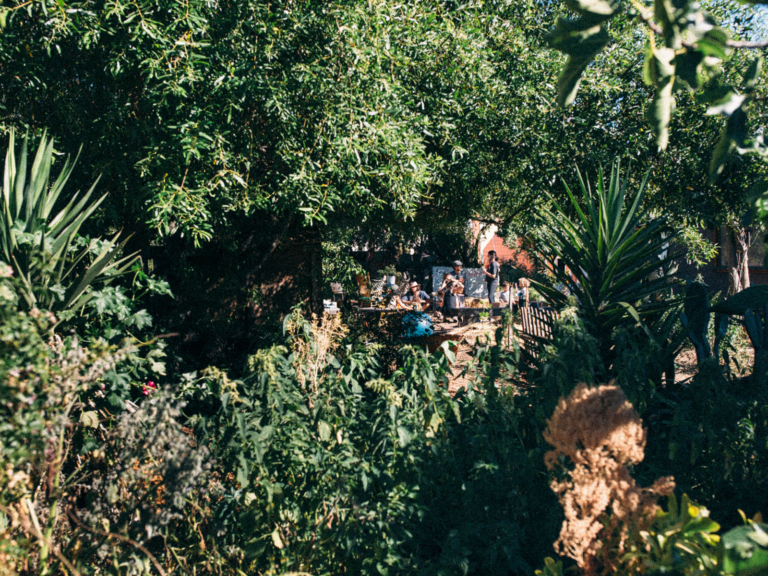
Canticle Farm is an urban garden, educational center and community of intention experimenting at the intersections of faith-based, social-justice-based and Earth-based nonviolent activism.
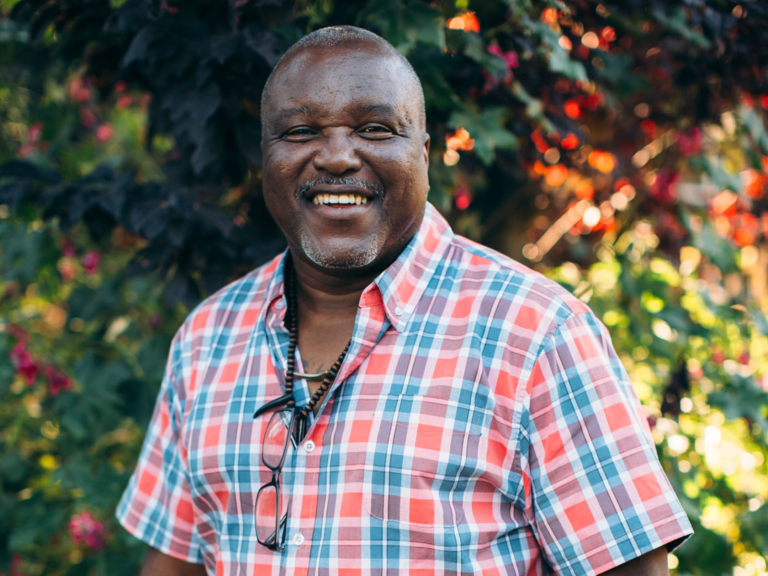
When Troy Williams first began going to the mountains after his release from prison, the solitude eerily reminded him of solitary confinement. But he stuck with it and connected.
CAMP PARADISE | Butte County, California
Where disaster response is forever work.
“Let’s gather around the campfire and restore paradise ….” Matthew Trumm listened to John D. Liu’s weirdly prophetic words in 2018, just 10 days before the Camp Fire—California’s deadliest and most destructive wildfire—killed 86 people and burned more than 18,000 structures. The megafire effectively destroyed the town of Paradise, California, where Matthew’s daughter lived with her mother.
In response to this catastrophe, Matthew founded Camp Paradise, the world’s first ecosystem restoration disaster-response camp. With no fixed location, Camp Paradise is a series of “pop-ups” and action days in and around the area known as the “Camp Fire burn scar,” where campers join local folks for hands-on restoration and permaculture projects to heal the land while also healing the community. With Camp Paradise, Matthew aims to transform our understanding of how to deliver ecosystem restoration in locations affected by the climate crisis, including land damaged by wildfires.
Passing through Paradise and the surrounding area today, you don’t see much of the apocalyptic destruction you might expect. The mess has mostly been cleaned up, apart from the odd burned-out car here and there. When I arrive, it’s a scorcher, well above 100 degrees, and the thing I cannot seem to find anywhere is shade. What was once a tree-lined community is now all open vistas. For those who remember the old Paradise, it is nearly unrecognizable.
When I meet Matthew on his property an hour outside of town, he’s wearing a wide-brimmed sun hat, working hard in the intense heat. This property also burned, but it was more recently in 2020, when the Bear Fire leveled the towns of Berry Creek and Feather Falls, giving this part of Northern California the dubious distinction as “the epicenter of wind-driven megafires.” I park next to Matthew’s burned-out husk of a pickup truck and wander among the blackened pillars of charred mature oaks, the understory completely gone, apart from Scotch broom shrubs and California lilac. Using a mini-excavator, he’s built a series of water-harvesting bioswales—an earthworks technique akin to terracing, creating level trenches and berming the soil downhill to help spread and sink water—which decrease erosion and increase the water storage capacity of the soil. Next, he creates micro-terraces, small furrows that are cover cropped with buckwheat and then mulched, all intended to stabilize soil and prevent erosion.
“All of the Earth’s soil should be covered,” Matthew says to me over his shoulder. “If you see exposed soil, think of it as a wound that needs to be dressed.” Exposed soil kills critical soil life and tips evaporation over condensation, creating drought and ultimately degrading the landscape, the perfect conditions for these colossal fires and corresponding floods.
Stabilizing soil is extremely important in the wake of wildfire. Heavy winter rains create landslides in freshly burned areas, making a bad situation worse. Here on his freshly burned property, Matthew is creating a permaculture demonstration site, an education center that focuses on fire restoration. “These massive, wind-driven fires are all so new,” he tells me, down on his hands and knees, spreading seed. “We don’t have much data yet on how it works to clean up after this many homes are burned.”
When a home—or neighborhood—burns, the wreckage is extremely toxic. The first order of operation is mitigating the toxic runoff, ensuring that the pollution doesn’t end up in rivers and streams. After the Camp Fire, Matthew led efforts to deploy materials often used in erosion control—straw waddles, compost socks and straw—to contain pollution around the burned homesites until those footprints are properly cleaned up and brought to hazardous waste facilities. With today’s large-scale fires, it’s often more than two rainy seasons before these sites are cleaned up, so protecting the watershed in the short term is critical. But nothing like this had ever been done. Matthew and his team of volunteers created a “best practices model” that has now been adopted by FEMA.
But according to Matthew, real solutions must be systemic. “We can’t just create systems for disaster response,” he tells me, leaning against the burned trunk of a madrone tree in a narrow swath of shade. “We need to be doing the work of ecosystem restoration all the time. We need to restore everything.” For Matthew, it’s a lifestyle, not a response. “That way, when a disaster happens or a seriously degraded area needs work, we’re already prepared, mentally and physically.”
Our conversation continues over beers on an outdoor patio in the historic town of Oroville. “These forests were being charged for millions of years, and we’ve removed that charge and are just running off the battery,” Matthew tells me as the sun sets and the temperature drops. “We are missing so many species. We don’t have the ocean input into the forests anymore. Salmon came up the rivers and bears carried their nutrients into the trees. We don’t have the beavers doing their work of slowing water. We don’t have millions of grazing animals fertilizing the grasslands anymore.”
I lean back in my chair, my slightly intoxicated mind absorbing what he’s saying. “So, when we are restoring land, we have to mimic all the work these animals were doing for us.” Matthew says, taking a slow drink of his beer before finishing. “We need our animal friends back on the land.”
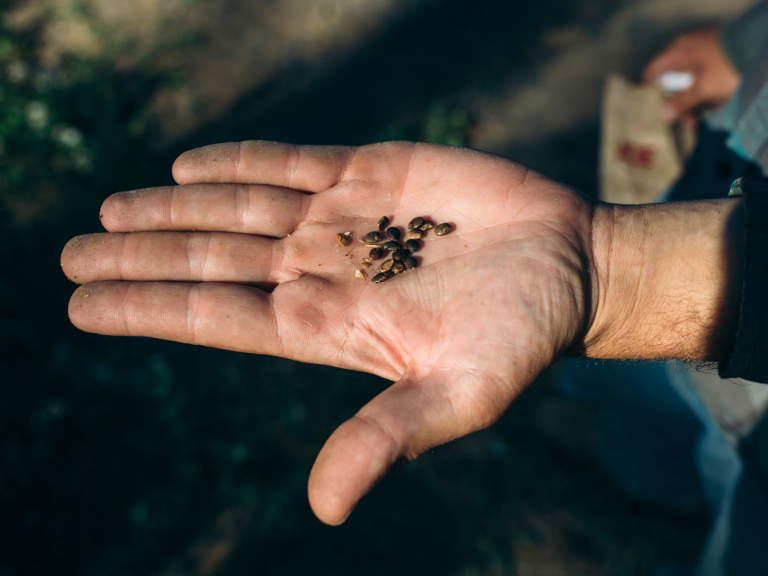
“We need to be doing the work of ecosystem restoration all the time,” Matthew says. “We need to restore everything.”
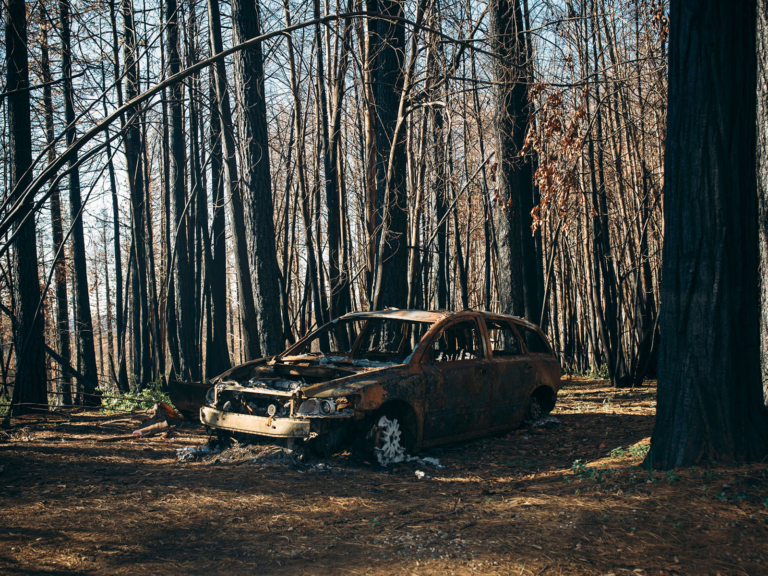
When a home—or neighborhood—burns, the wreckage is extremely toxic. The first order of operation is mitigating the toxic runoff to ensure that the pollution doesn’t end up in rivers and streams.
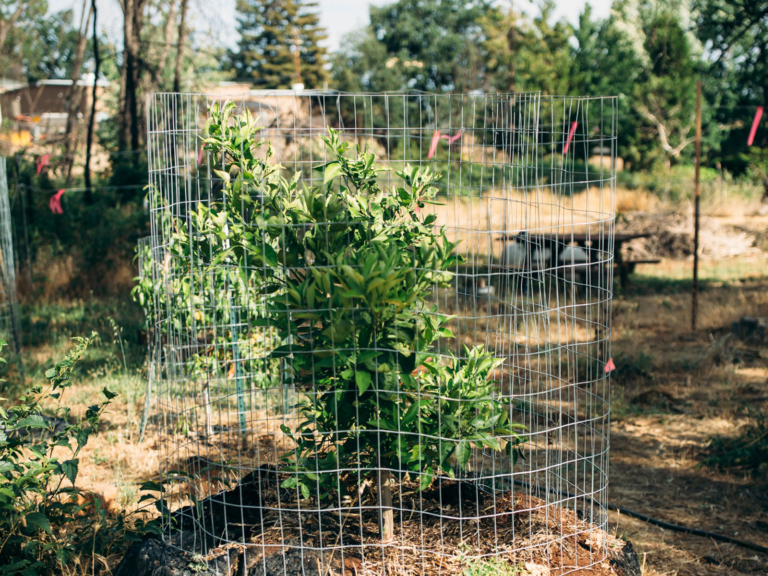
Restoring Paradise.
CAMP HOTLUM | Siskiyou County, California
Regenerating out of the ashes.
I meet Jonathan Kabat, cofounder of Camp Hotlum, at the Hi-Lo Café in Weed, California, on the flanks of Mount Shasta. Outside the window, I can see the devastation left behind by decades of commercial logging. “You become deeply attached to a child or animal through caring for them,” Jonathan tells me. “At Hotlum, you care for the land and become reconnected to nature.”
Over the next few days, we work on a fire mitigation project with a group of volunteers, planting ponderosas and removing manzanita and bitter brush. We camp under the stars, the Milky Way stretching gloriously overhead. It’s hard but satisfying work under the hot summer sun. A few days after I left, lightning ignited the Lava Fire and wind-driven flames engulfed Hotlum. All structures and 95 percent of its trees were consumed.
I reconnected with Jonathan a year later, and he reported good signs at Hotlum; the seedbank is intact and wildflowers are popping up. He found his first morel the other day. Oaks are resprouting from charred stumps and the Hotlum crew has planted 500 trees. Some of the old growth—canyon live oaks, ponderosa, mountain mahogany, Douglas fir, white fir and incense cedar—survived the fire and subsequent landslides.
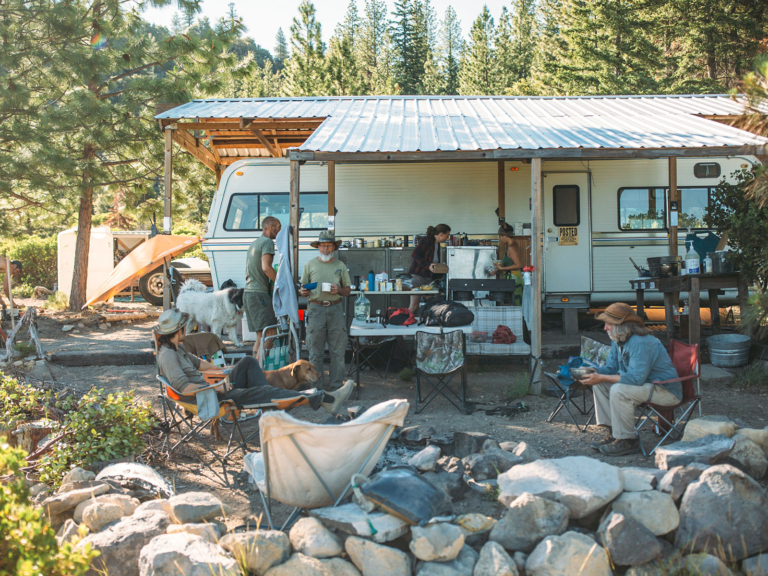
The Camp Hotlum crew takes a break just days before the Lava Fire ignited and burned 26,409 acres along the slopes of Mount Shasta.
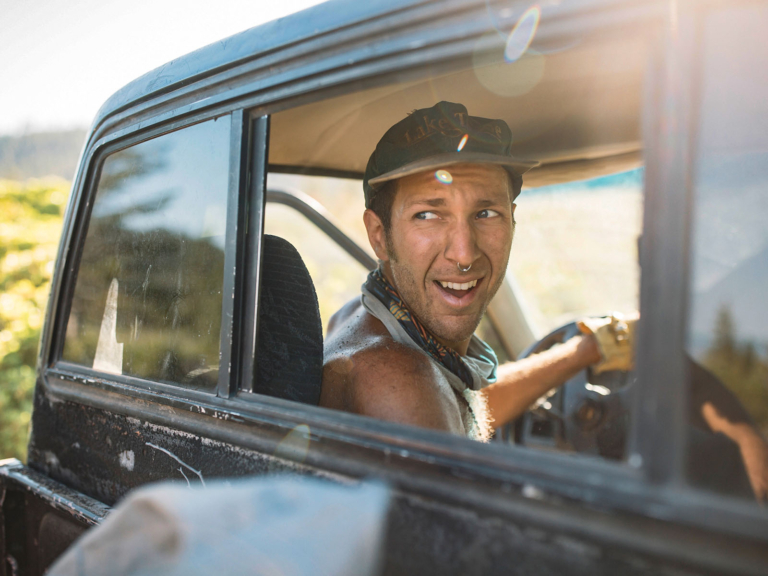
Leo Lauchere, up from EcoCamp Coyote, helps remove manzanita and bitterbrush at Hotlum to mitigate the risk of wildfire.
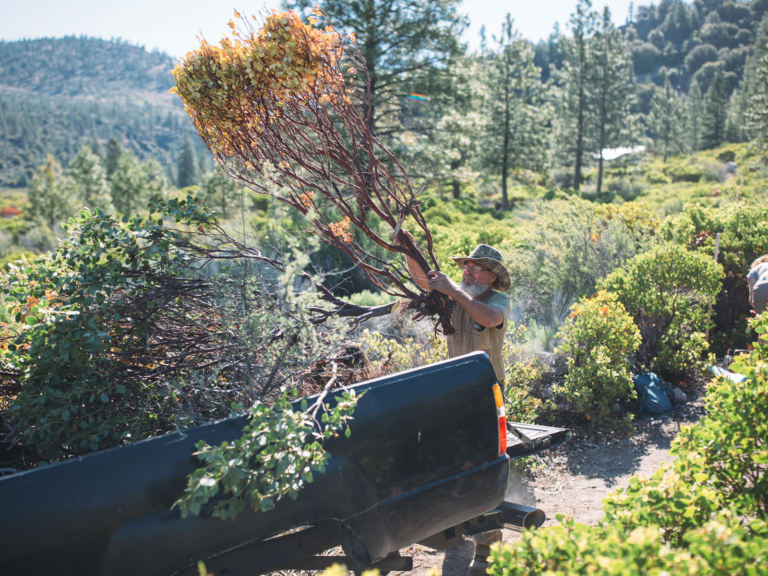
Jonathan Kabat throws a manzanita bush in the back of his pickup just days before the Lava Fire swept through the landscape.
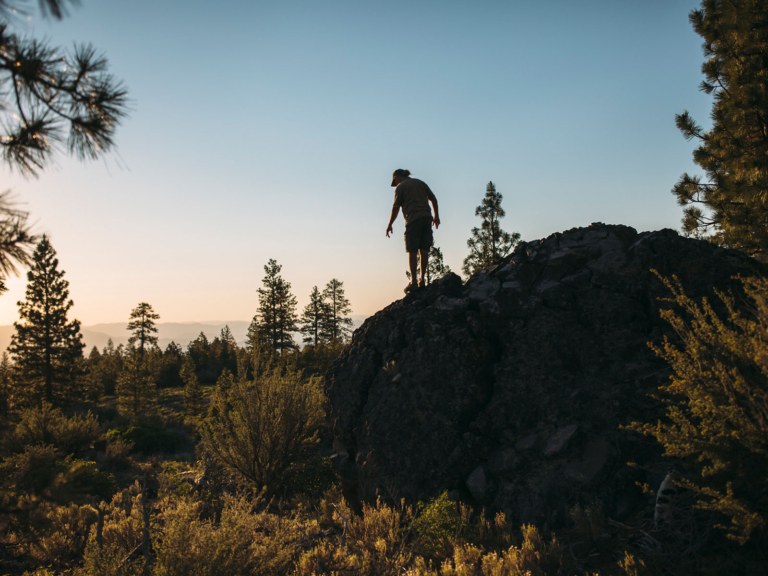
The landscape, pre-Lava Fire. Today, oaks are resprouting from charred stumps and the Hotlum crew has planted 500 trees.
QUAIL SPRINGS | Ventura County, California
An abandoned spring supports a new community.
Listen to Brenton talk resilience
Transcript
Brenton: It wasn’t ownership. It had no interest in being title to land, but deeply attached to it nonetheless. To really feel in my in my own hands some of the more tangible things that support my life– where the water comes from, where the lights turn on and how to build and how to, you know, not to be to be self-sufficient in the sense that I didn’t need anything else but to be resilient in the sense that I could take care of those things that sustain me and nurture them and feed them and honor them.
I pull off at a nondescript driveway, enter a code in a lockbox and drive slowly east through a series of gates to Quail Springs (QS), the dry badland canyons looming large. The Cuyama Valley is the driest place in coastal Central California—receiving only five inches of rainfall annually—while also having one of the most over-drafted groundwater basins in the state. While the Chumash people have lived here for an estimated 10,000 years, it has taken less than a century for private property owners to extract to a point where the valley is in significant decline.
A sustainable community originally created with the intention of getting children into nature, QS today organizes itself around a five-pronged ethos: growing food in the high desert in a way that builds healthy soil; protecting the local watershed by promoting sustainable groundwater policies; teaching permaculture, natural building and land-based skills online; advocacy for fire-resistant, climate-appropriate earthen homes; and community outreach in the underserved Cuyama Valley. The community members and staff who live and work here are joined by work traders who stay on the property for three to six months.
When I meet Brenton Kelly, an early QS board member who moved here with his wife Jan in 2008, he’s building a cob bench between their elegant earthen home and their abundant garden. The wet, rhythmic slaps of his muddy trowel blend with the buzzing of pollinators on white sage. Nearby, someone tunes a stringed instrument. He washes the earth and straw mix from his hands and bends down to rub the ears of one of two resident giant Great Pyrenees lolling in the shade.
“This used to be quite undeveloped,” Brenton tells me, not looking up from his work. “There was no one living on the land. But over the years we’ve created a canopy of shade trees and built structures to keep people comfortable.”
For 75 years, the previous owners ran 20 head of cattle on the property that is now Quail Springs, gradually degrading the creek until it was presumed that the spring had dried up. “For the most part, just removing the cattle allowed the spring to regenerate,” Brenton tells me. Through careful observation and studying under the wetlands restoration designer, Craig Sponholtz, Brenton eventually felt competent enough to intervene in the stream restoration. He constructed a few gabions—cages filled with rocks used to prevent erosion—before switching to sandbags impregnated with mat sedge root rhizomes, which allow roots to sprout through the failing burlap, becoming a permanent part of the stream bank and accelerating the natural restoration.
As the wetlands healed, they began to produce more water, to the tune of 5 gallons a minute. Today, 99 percent of the farm’s daily water demands—irrigation for an acre of farm garden, water for 20 Nubian goats and chickens, water for showering and cleaning for 20 residents—are supplied by the spring (a solar-powered well provides the community’s drinking water). A canopy of cottonwoods, black locusts and poplar provide precious shade and stand testament to the renewed flow.
The sun falls behind the ridge to the west, casting long shadows through the valley. The Muddy Daughters assemble, tune up their instruments and sing original songs in praise of and gratitude for the land that sustains them. I hear a covey of California quail in the distance, calling chi-CA-go! I follow Anton, a new work trader, as he takes the goats for a walk, staff in hand. Silhouetted in the sun, he appears the biblical shepherd leading his flock through the valley, a moment outside of time.
Listen to Ashwin talk about reconnecting with land
Transcript
Ashwin: I wanted a complete disassociation from the electronic world. And so this place offered this opportunity and I took it as a work trader. So I lived in a tent for four months, close to five months. I took goats out on walks. I spent time with the land. I learned basics of irrigation, basics of tending animals, which in this environment were also opening me up to the cosmic relationship between the stars you’d see at night and the minutiae of the flora and fauna on the desert floor.
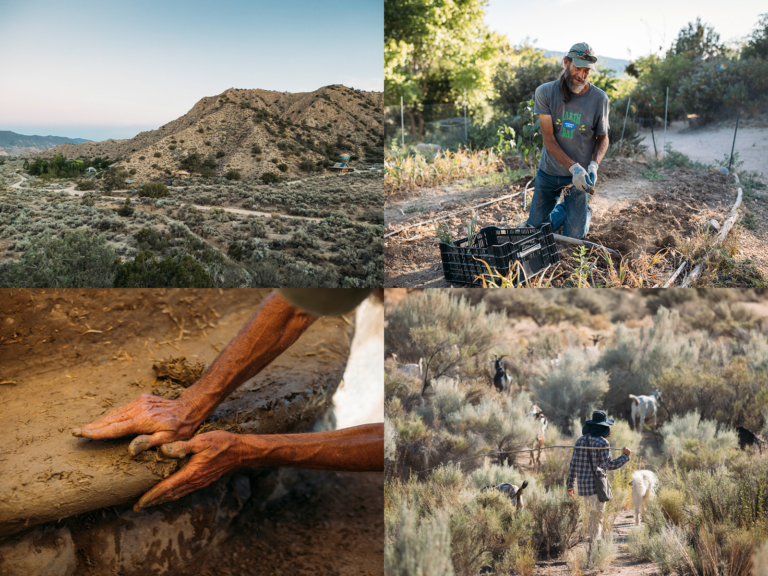
(Top Left) At Quail Springs (QS) in Cuyama Valley, California, a mishmash of yurts, greenhouses, shipping containers and cob structures are loosely organized around a deep green, spring-fed oasis—the lifeblood of the community. (Top Right) Brenton Kelly harvests garlic. His father worked as a Voice of America war correspondent while raising Brenton all over Africa. As a kid, he was exposed to intact cultures living a subsistence lifestyle, creating sustenance without a global market. “Subsistence was never a derogatory term,” he says. (Bottom Right) Anton, a work trader, takes the goats for a walk. (Bottom Left) Building and advocacy around fire-resistant, climate-appropriate earthen homes is one of QSP’s four main areas of focus.
CAMP BIRDHOUSE | Los Angeles County, California
Recasting the Hollywood Hills.
“Hollywood is important,” Jonny Allen tells me over coffee and toast with his partner Bella LeNestour. “Because this is where stories are told. This is where our dystopian futures are created, through media, and we could have an impact on that by telling a new story of interdependence and possibility. That’s as much our work as learning to cultivate the soil.”
Bella and Jonny, both artists, founded Camp BirdHouse together—a community garden and ERC a mile from the Hollywood sign in Los Angeles—to answer a paramount question: How do we live a life that the planet now demands? Their garden is a food forest, bursting with edible perennial plants, fruit and nut trees planted to support biodiversity and improve the health of the soil. Two residential buildings on the property send grey water to the garden from sinks, showers and appliances. To prevent evaporation, they mulch and cover the soil; an extensive tree canopy helps manage the amount of sunlight that reaches the ground.
Unable to afford a large tract of land in the pricey Hollywood Hills, the BirdHouse team creates relationships with neighbors who buy into the project and participate in regenerating their land, creating a mosaic of biodiversity within the urban landscape. One plot is dedicated to a medicinal herb garden while another is focused on food production. A third parcel, owned by the city, became a demonstration site to show how a severely desertified piece of land can be transformed into a wildlife corridor.
Listen to Jonny talk about the importance of imagination
Transcript
Jonny: Hollywood is important to us because this is where stories are told. This is where our futures are designed, in a sense, through media, and that we could have an impact on that because most people live in a world of resignation, and we believe that it just takes imagination. And once we have developed the skill of imagining a more beautiful future, we can live into that future. And that’s, I’d say, as much our work as learning to cultivate the soil, which we do.
“The moment you begin paying attention and developing a relationship with plants,” Bella tells me, “You can’t say, let’s put a parking lot here instead.” Handing me an apricot from a nearby tree, Jonny pauses his harvest to look through the canopy at the Los Angeles sprawl below. “Most people live in a world of unrecognized resignation,” he says. “We believe it just takes imagination—we need to develop the skill of imagining—and then we can live into that more beautiful future.”
After saying farewell to Jonny and Bella, it’s time for me to head home to South Carolina. Descending into the LA traffic en route to the airport, the faces, places and voices I’ve encountered during this tour of California flash through my mind, warring with the endless concrete and garbage-strewn streets to capture my imagination and establish the dominant narrative. The folks I’ve met refuse to give up on working toward a better future. They stand in defiance of the prevailing paradigm, modeling a better way of living. And I choose to join them. As John D. Liu says, “This is the great work of our time.”
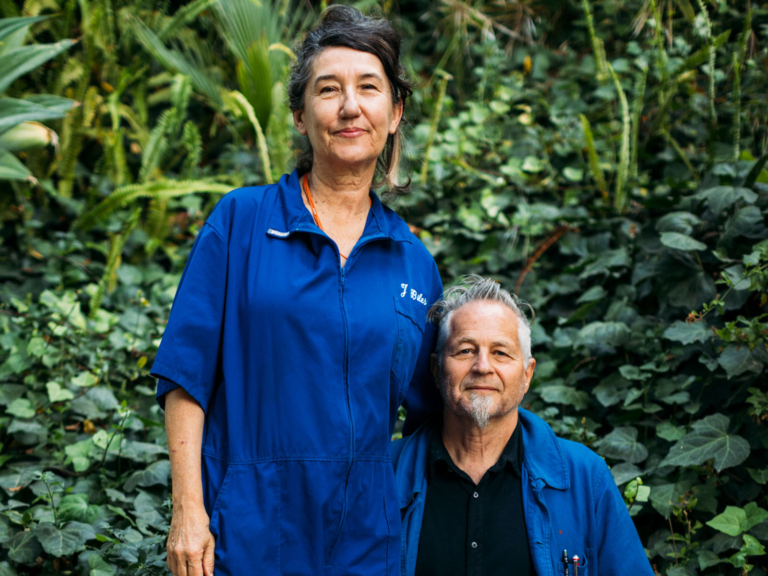
Bella LeNestour and Jonny Allen formed Camp BirdHouse to answer an important question: How do we live a life that the planet now demands?
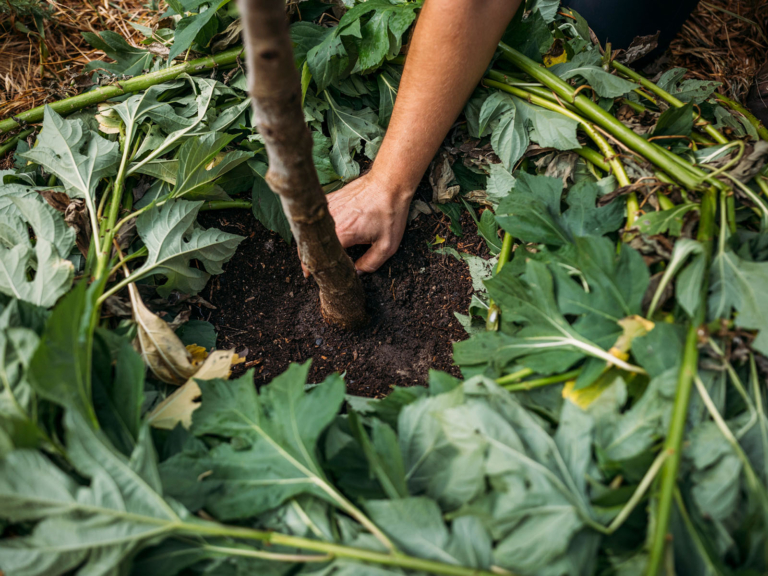
BirdHouse Ecological Programs Manager Cameron Miller mulches around the base of a fruit tree. This “chop and drop” method keeps water at the base of the tree but doesn’t touch it, so as not to rot the trunk.
